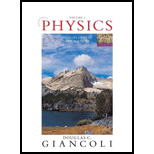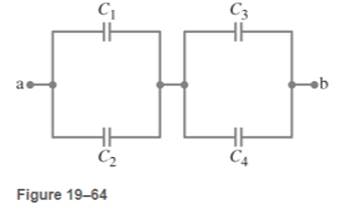
Physics: Principles and Applications -- Pearson e Text Instant Access (Pearson+)
7th Edition
ISBN: 9780137679065
Author: Douglas Giancoli
Publisher: PEARSON+
expand_more
expand_more
format_list_bulleted
Concept explainers
Textbook Question
Chapter 19, Problem 44P
Determine the equivalent capacitance between points a and b for the combination of capacitors shown in Fig. 19-64.

Expert Solution & Answer
Want to see the full answer?
Check out a sample textbook solution
Students have asked these similar questions
pls help on these
pls help on these
20. Two small conducting spheres are placed on top of insulating pads. The 3.7 × 10-10 C sphere is fixed whie
the 3.0 × 107 C sphere, initially at rest, is free to move. The mass of each sphere is 0.09 kg. If the spheres
are initially 0.10 m apart, how fast will the sphere be moving when they are 1.5 m apart?
Chapter 19 Solutions
Physics: Principles and Applications -- Pearson e Text Instant Access (Pearson+)
Ch. 19 - Prob. 1OQCh. 19 - Prob. 1QCh. 19 - Prob. 2QCh. 19 - Prob. 3QCh. 19 - Prob. 4QCh. 19 - Prob. 5QCh. 19 - Prob. 6QCh. 19 - Prob. 7QCh. 19 - Prob. 8QCh. 19 - Prob. 9Q
Ch. 19 - Prob. 10QCh. 19 - Prob. 11QCh. 19 - Prob. 12QCh. 19 - Prob. 13QCh. 19 - Prob. 14QCh. 19 - Prob. 15QCh. 19 - Given the circuit shown in Fig. 19-38, use the...Ch. 19 - Prob. 17QCh. 19 - Prob. 18QCh. 19 - 19. What is the main difference between an analog...Ch. 19 - What would happen if you mistakenly used an...Ch. 19 - Prob. 21QCh. 19 - Prob. 22QCh. 19 - Prob. 23QCh. 19 - Prob. 1MCQCh. 19 - Prob. 2MCQCh. 19 - Prob. 3MCQCh. 19 - Prob. 4MCQCh. 19 - Prob. 5MCQCh. 19 - Prob. 6MCQCh. 19 - Prob. 7MCQCh. 19 - Prob. 8MCQCh. 19 - Prob. 9MCQCh. 19 - Prob. 10MCQCh. 19 - Prob. 11MCQCh. 19 - Prob. 12MCQCh. 19 - Prob. 13MCQCh. 19 - Prob. 14MCQCh. 19 - Prob. 15MCQCh. 19 - Calculate the terminal voltage for a battery with...Ch. 19 - Prob. 2PCh. 19 - What is the internal resistance of a 12.0-V car...Ch. 19 - A 650-O and an 1800-O resistor are connected in...Ch. 19 - Prob. 5PCh. 19 - Suppose that you have a 580-O, a 790-O, and a...Ch. 19 - Prob. 7PCh. 19 - Prob. 8PCh. 19 - Prob. 9PCh. 19 - Prob. 10PCh. 19 - Prob. 11PCh. 19 - Eight identical bulbs are connected in series...Ch. 19 - Prob. 13PCh. 19 - Prob. 14PCh. 19 - Prob. 15PCh. 19 - Determine (a) the equivalent resistance of the...Ch. 19 - Prob. 17PCh. 19 - (a) Determine the equivalent resistance of the...Ch. 19 - What is the net resistance of the circuit...Ch. 19 - Prob. 20PCh. 19 - Prob. 21PCh. 19 - Prob. 22PCh. 19 - Prob. 23PCh. 19 - Consider the network of resistors shown in Fig....Ch. 19 - Calculate the current in the circuit of Fig....Ch. 19 - Determine the terminal voltage of each battery in...Ch. 19 - For the circuit shown in Fig.19-55, find the...Ch. 19 - Determine the magnitudes and directions of the...Ch. 19 - (a) What is the potential difference between...Ch. 19 - Prob. 30PCh. 19 - 31. (II) Determine the magnitudes V1= 9.0 V R1, =...Ch. 19 - Prob. 32PCh. 19 - Prob. 33PCh. 19 - (a) Determine the currents l1,l2 and l3 in Fig....Ch. 19 - Prob. 35PCh. 19 - Prob. 36PCh. 19 - Prob. 37PCh. 19 - Prob. 38PCh. 19 - A 3.00-F and a 4.00-F capacitor are connected in...Ch. 19 - If 21.0 V is applied across the whole network of...Ch. 19 - The capacitance of a portion of a circuit is to be...Ch. 19 - An electric circuit was accidentally constructed...Ch. 19 - Consider three capacitors, of capacitance 3200...Ch. 19 - Determine the equivalent capacitance between...Ch. 19 - What is the ration of the voltage V1 across...Ch. 19 - A 0.50-F and a 1.4-F capacitor are connected in...Ch. 19 - A circuit contains a single 250-pF capacitor...Ch. 19 - Prob. 48PCh. 19 - Prob. 49PCh. 19 - Given three capacitors. C1= 2.0$ mUF, C2= 1.5 F,...Ch. 19 - Prob. 51PCh. 19 - Prob. 52PCh. 19 - Prob. 53PCh. 19 - In Fig. 19-69 (same as Fig. 19-20a ), the total...Ch. 19 - Prob. 55PCh. 19 - Prob. 56PCh. 19 - Prob. 57PCh. 19 - Two resistors and two uncharged capacitors are...Ch. 19 - Prob. 59PCh. 19 - Prob. 60PCh. 19 - Prob. 61PCh. 19 - A galvanometer has an internal resistance of 32 ...Ch. 19 - Prob. 63PCh. 19 - Prob. 64PCh. 19 - Prob. 65PCh. 19 - Prob. 66PCh. 19 - Prob. 67GPCh. 19 - Prob. 68GPCh. 19 - Prob. 69GPCh. 19 - Prob. 70GPCh. 19 - A heart pacemaker is designed to operate at 72...Ch. 19 - Prob. 72GPCh. 19 - Prob. 73GPCh. 19 - Prob. 74GPCh. 19 - Prob. 75GPCh. 19 - Prob. 76GPCh. 19 - Prob. 77GPCh. 19 - Prob. 78GPCh. 19 - Prob. 79GPCh. 19 - Prob. 80GPCh. 19 - Prob. 81GPCh. 19 - Prob. 82GPCh. 19 - Prob. 83GPCh. 19 - (a) What is the equivlaent resistance of the...Ch. 19 - Prob. 85GPCh. 19 - Prob. 86GPCh. 19 - Prob. 87GPCh. 19 - In Fig. 19-86, let V= 10.0 V and C1=C2=C3=25.4 F....Ch. 19 - 89. A 12.0-V battery, two resistors, and two...Ch. 19 - Prob. 90GPCh. 19 - Prob. 91GPCh. 19 - Prob. 92GPCh. 19 - Prob. 93GPCh. 19 - Prob. 94GPCh. 19 - The variable capacitance of an old radio tuner...Ch. 19 - Prob. 96GPCh. 19 - Prob. 97GP
Knowledge Booster
Learn more about
Need a deep-dive on the concept behind this application? Look no further. Learn more about this topic, physics and related others by exploring similar questions and additional content below.Similar questions
- pls help on all asked questions kindlyarrow_forward19. Mount Everest, Earth's highest mountain above sea level, has a peak of 8849 m above sea level. Assume that sea level defines the height of Earth's surface. (re = 6.38 × 106 m, ME = 5.98 × 1024 kg, G = 6.67 × 10 -11 Nm²/kg²) a. Calculate the strength of Earth's gravitational field at a point at the peak of Mount Everest. b. What is the ratio of the strength of Earth's gravitational field at a point 644416m below the surface of the Earth to a point at the top of Mount Everest? C. A tourist watching the sunrise on top of Mount Everest observes a satellite orbiting Earth at an altitude 3580 km above his position. Determine the speed of the satellite.arrow_forwardpls help on allarrow_forward
- pls help on allarrow_forward6. As the distance between two charges decreases, the magnitude of the electric potential energy of the two-charge system: a) Always increases b) Always decreases c) Increases if the charges have the same sign, decreases if they have the opposite signs d) Increases if the charges have the opposite sign, decreases if they have the same sign 7. To analyze the motion of an elastic collision between two charged particles we use conservation of & a) Energy, Velocity b) Momentum, Force c) Mass, Momentum d) Energy, Momentum e) Kinetic Energy, Potential Energyarrow_forwardpls help on all asked questions kindlyarrow_forward
- pls help on all asked questions kindlyarrow_forward17. Two charges, one of charge +2.5 × 10-5 C and the other of charge +3.7 × 10-6 C, are 25.0 cm apart. The +2.5 × 10−5 C charge is to the left of the +3.7 × 10−6 C charge. a. Draw a diagram showing the point charges and label a point Y that is 20.0 cm to the left of the +3.7 × 10-6 C charge, on the line connecting the charges. (Field lines do not need to be drawn.) b. Calculate the net electric field at point Y.arrow_forward3arrow_forward
arrow_back_ios
SEE MORE QUESTIONS
arrow_forward_ios
Recommended textbooks for you

 Physics for Scientists and Engineers, Technology ...PhysicsISBN:9781305116399Author:Raymond A. Serway, John W. JewettPublisher:Cengage Learning
Physics for Scientists and Engineers, Technology ...PhysicsISBN:9781305116399Author:Raymond A. Serway, John W. JewettPublisher:Cengage Learning Principles of Physics: A Calculus-Based TextPhysicsISBN:9781133104261Author:Raymond A. Serway, John W. JewettPublisher:Cengage Learning
Principles of Physics: A Calculus-Based TextPhysicsISBN:9781133104261Author:Raymond A. Serway, John W. JewettPublisher:Cengage Learning College PhysicsPhysicsISBN:9781938168000Author:Paul Peter Urone, Roger HinrichsPublisher:OpenStax College
College PhysicsPhysicsISBN:9781938168000Author:Paul Peter Urone, Roger HinrichsPublisher:OpenStax College Physics for Scientists and Engineers: Foundations...PhysicsISBN:9781133939146Author:Katz, Debora M.Publisher:Cengage Learning
Physics for Scientists and Engineers: Foundations...PhysicsISBN:9781133939146Author:Katz, Debora M.Publisher:Cengage Learning Physics for Scientists and EngineersPhysicsISBN:9781337553278Author:Raymond A. Serway, John W. JewettPublisher:Cengage Learning
Physics for Scientists and EngineersPhysicsISBN:9781337553278Author:Raymond A. Serway, John W. JewettPublisher:Cengage Learning


Physics for Scientists and Engineers, Technology ...
Physics
ISBN:9781305116399
Author:Raymond A. Serway, John W. Jewett
Publisher:Cengage Learning

Principles of Physics: A Calculus-Based Text
Physics
ISBN:9781133104261
Author:Raymond A. Serway, John W. Jewett
Publisher:Cengage Learning

College Physics
Physics
ISBN:9781938168000
Author:Paul Peter Urone, Roger Hinrichs
Publisher:OpenStax College

Physics for Scientists and Engineers: Foundations...
Physics
ISBN:9781133939146
Author:Katz, Debora M.
Publisher:Cengage Learning

Physics for Scientists and Engineers
Physics
ISBN:9781337553278
Author:Raymond A. Serway, John W. Jewett
Publisher:Cengage Learning
Physics Capacitor & Capacitance part 7 (Parallel Plate capacitor) CBSE class 12; Author: LearnoHub - Class 11, 12;https://www.youtube.com/watch?v=JoW6UstbZ7Y;License: Standard YouTube License, CC-BY